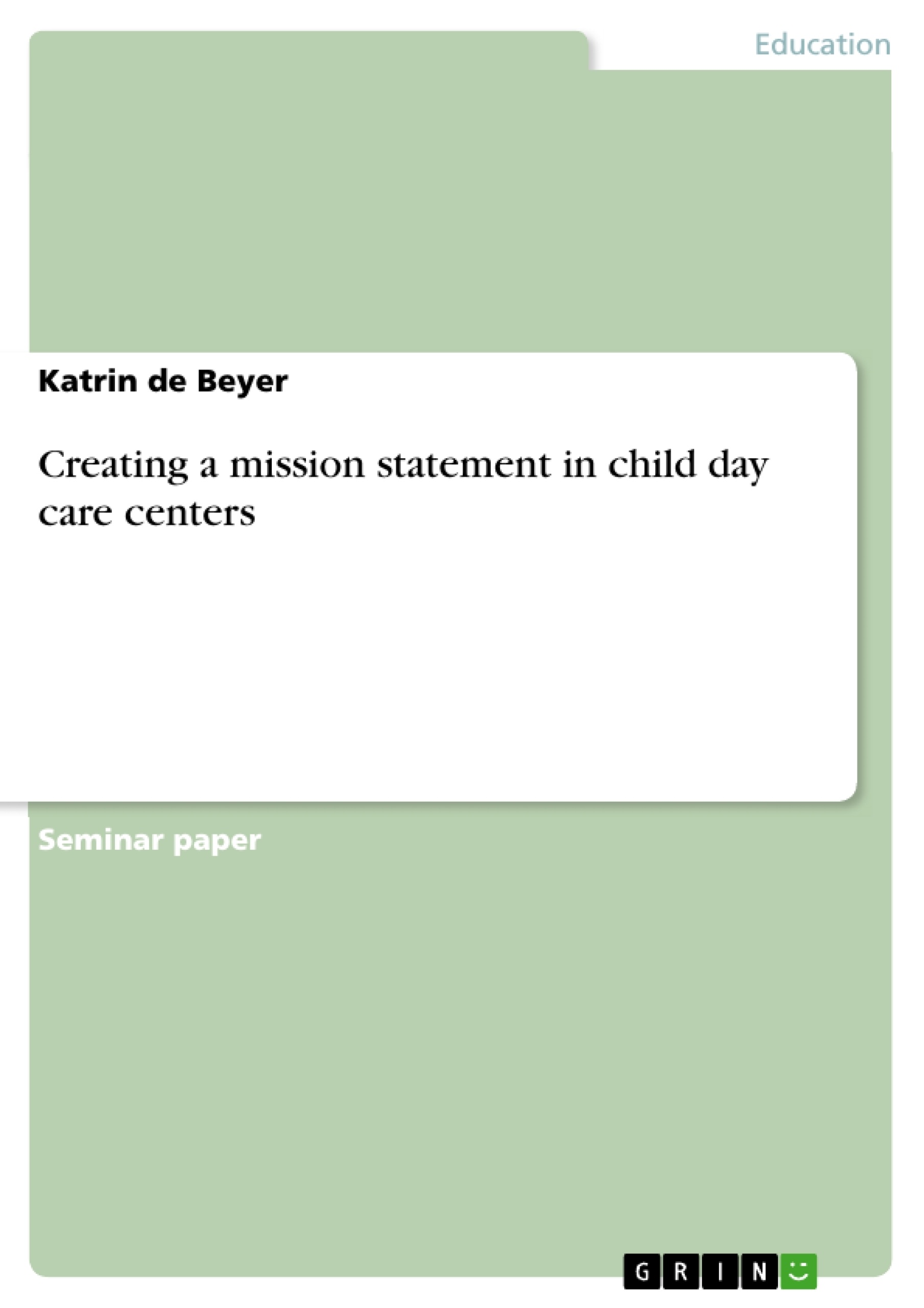This paper contains the most important information about a mission statement in day care centers and a personal statement on the two questions "Does it make sense if the mission statement is already given by the responsible body?" and "What speaks for or against an external consultant in the creation of a mission statement?".
At the beginning, an illustration is presented in which the different forms of daycare center work are described and the term mission statement is classified.
This is followed by an explanation of the term "mission statement" in relation to daycare centers and a presentation of the framework conditions for creating one and the benefits of doing so.
This is followed by the presentation of two methods for creating a mission statement, with which it is possible to work out and visualize the values of a team. These are exemplarily the water lily model and the value profile according to Steven Reiss.
This is followed by the process of creating a mission statement. Here, general information is given on how to carry it out, structuring aids for formulating it, and methodological suggestions on how to implement the mission statement.
The last chapter deals with the question "Does it make sense if the mission statement is already given by the executing agency?" and the question "What speaks for or against an external consultant in the creation of a mission statement?" Both questions are considered independently of each other and a separate conclusion has been drawn for each question.
Table of Contents
- Introduction
- A mission statement
- What is necessary to create a mission statement..
- Functions of a mission statement....
- Reasons for a mission statement development.
- Methods for creating a mission statement...
- The water lily model
- The use of the water lily model...
- The value profile of Steven Reiss
- The use of the value profile.
- Process of creating a mission statement.
- Structuring of the mission statement..
- Implementation..
- Conclusion...........
- "Does it make sense if the mission statement is already specified by the carrier?"
- "What speaks for or against an external consultant in the creation of a mission statement?"
Objectives and Key Themes
This term paper aims to provide a comprehensive overview of mission statements in daycare centers, focusing on their creation, application, and importance. It further explores the practical implications of pre-defined mission statements and the potential benefits and drawbacks of involving external consultants in the development process.
- Defining and understanding mission statements in daycare centers
- Methods and tools for creating effective mission statements
- The role of values and individual motivation in mission statement development
- The impact of pre-defined mission statements on daycare center operations
- The pros and cons of engaging external consultants in mission statement creation
Chapter Summaries
- Introduction: Provides an introduction to the topic of mission statements in daycare centers and outlines the paper's structure and key questions.
- A mission statement: Defines a mission statement within the context of daycare centers, highlighting its importance as a foundation for pedagogical work and cultural identity. This chapter also introduces the model of Viva Fialka, which serves as a framework for understanding the components of a mission statement.
- What is necessary to create a mission statement: Discusses the essential elements and steps involved in developing a mission statement, emphasizing the need for collective involvement, leadership, and resources.
- Functions of a mission statement: Explains the different purposes a mission statement serves for employees, managers, and external stakeholders, highlighting its value as a tool for communication, collaboration, and quality assurance.
- Reasons for a mission statement development: Identifies various situations where the development of a mission statement becomes necessary, such as changes in leadership, legal structures, or team dynamics.
- Methods for creating a mission statement: Presents two distinct methods for developing and visualizing the values of a team: the water lily model and the value profile according to Steven Reiss.
- The water lily model: Explains the water lily model, a visual representation of values, attitudes, and behaviors in a team context, and demonstrates its application in identifying shared values through analyzing behavior in key situations.
- The value profile of Steven Reiss: Introduces the value profile of Steven Reiss, a tool based on 16 life motives that can be used to assess and align individual values within a team, facilitating communication and minimizing conflict.
- Process of creating a mission statement: Provides general information on structuring, implementing, and using a mission statement, offering practical guidance for the development process.
Keywords
This work focuses on the key concepts of mission statements, daycare centers, value profiles, the water lily model, Steven Reiss, pedagogical work, team collaboration, and external consultants. It explores the creation, implementation, and impact of mission statements in the context of fostering a shared vision and values within daycare center environments.
- Quote paper
- Katrin de Beyer (Author), 2015, Creating a mission statement in child day care centers, Munich, GRIN Verlag, https://www.grin.com/document/1190301




